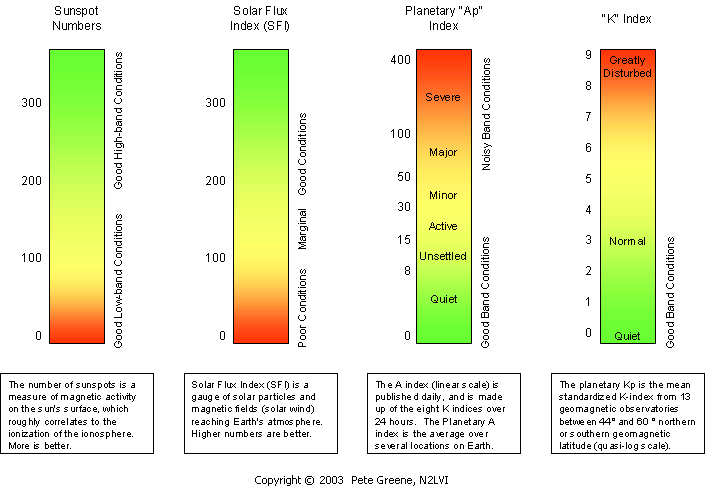
Graphics: Auroral Activity | Solar
X-Ray Flux | Sunspots | SOHO
| D-Region Asorbtion | MUF | Solar
X-Ray Absorption | E-Layer

Current Index Numbers from WWV
| SOLAR FLUX INDEX (SFI)
While increasing SFI may be good for HF propagation, it also tends to correspond with high Ap and K indices, which cause D-Layer absorption and noisy band condition. Solar flux is measured in solar flux units (SFUs). It is the amount of radio noise or flux emitted at a frequency of 2800 MHz (10.7 cm, hence is it also called the 10.7 cm flux index). NOAA broadcasts geophysical alert messages over WWV at 18 minutes after the hour and from WWVH at 45 minutes after the hour. The messages are less than 45 seconds in length and are updated every 3 hours (typically at 0000, 0300, 0600, 0900, 1200, 1500, 1800, and 2100 UTC).
|
||||||||||||||||||||||||
|
The subscript "p" means planetary and designates a global magnetic activity index. The following 13 observatories, which lie between 46 and 63 degrees north and south geomagnetic latitude, now contribute to the planetary indices: Lerwick (UK), Eskdalemuir (UK), Hartland (UK), Ottawa (Canada), Fredericksburg (USA), Meannook (Canada), Sitka (USA), Eyrewell (New Zealand), Canberra (Australia), Lovo (Sweden), Brorfelde (Denmark), Wingst (Germany), and Niemegk (Germany).
|
||||||||||||||||||||||||
|
K indices isolate solar particle effects on the earth's magnetic field; over a 3-hour period, they classify into disturbance levels the range of variation of the more unsettled horizontal field component. Each activity level relates almost logarithmically to its corresponding disturbance amplitude. Three-hour indices discriminate conservatively between true magnetic field perturbations and the quiet-day variations produced by ionospheric currents. K indices range in 28 steps from 0 (quiet) to 9 (greatly disturbed) with fractional parts expressed in thirds of a unit. A K-value equal to 27, for example, means 2 and 2/3 or 3-; a K-value equal to 30 means 3 and 0/3 or 3 exactly; and a K-value equal to 33 means 3 and 1/3 or 3+. The arithmetic mean of the K values scaled at the 13 observatories listed above gives Kp.
|
||||||||||||||||||||||||
|
EQUIVALENT AMPLITUDE The a-index ranges from 0 to 400 and represents a K-value converted to a linear scale in gammas (nanoTeslas, nT) – a scale that measures equivalent disturbance amplitude of a station at which K=9 has a lower limit of 400 gammas.
|
||||||||||||||||||||||||
|
|||||
Auroral Activity (North)Click on map for NOAA
website |
Auroral Activity (South)Click on map for NOAA website |
Solar X-Ray Flux |
|||
SunspotsClick on image for NASA Sunspot
website |
SOHO Solar Images
|
D-Region AbsorptionClick on map for NOAA website
|
|||
Maximum Useable
|
20 MHz Solar X-Ray
|
E-Layer Critical
|
|||
Additional Web Referenceshttp://www2.arrl.org/tis/info/pdf/0209038.pdf ARRL - Understanding Solar Indices, by Ian Poole, G3YWX http://www.spaceweather.com Daily space weather updates http://www.dxlc.com/solar Solar Terrestrial Activity Report http://crlgin.nict.go.jp/sedoss/solact3 Solar-Terrestrial Activity Chart (Japan) http://www.sec.noaa.gov/ftpdir/indices/DGD.txt Recent K and A values http://sidc.oma.be Space Weather: The International Journal of Research and Applications (Belgium) http://solarscience.msfc.nasa.gov/SunspotCycle.shtml The Sunspot Cycle http://www.spaceweather.com/glossary/sunspotnumber.html Sunspot numbers and 400-year chart http://www.eham.net/DX/propagation Links to many useful websites, with relevance ratings http://www.ngdc.noaa.gov/stp/GLOSSARY/glossary.html Glossary http://www.arrl.org/tis/info/k9la-prop.html ARRL tutorial on solar effects on propagation http://www.sunspot.noao.edu/PR/answerbook/sunspots.html Sunspot answer book http://www.sec.noaa.gov/radio NOAA's Space Environment Center Radio User's Data http://soho.nascom.nasa.gov Current SOHO images http://www.dxinfocentre.com/tropo.html William Hepburn's Tropospheric Ducting Forecast http://www.arrl.org/w1aw/prop ARRL Propagation Bulletins
|
Victor Amateur Radio Association Home Page
|
Page Maintained by Pete Greene,
N2LVI Contact: Peter Greene, N2LVI Last Updated: 25 July 2012 © 2003-2012 Victor Amateur Radio Association. All rights reserved. |